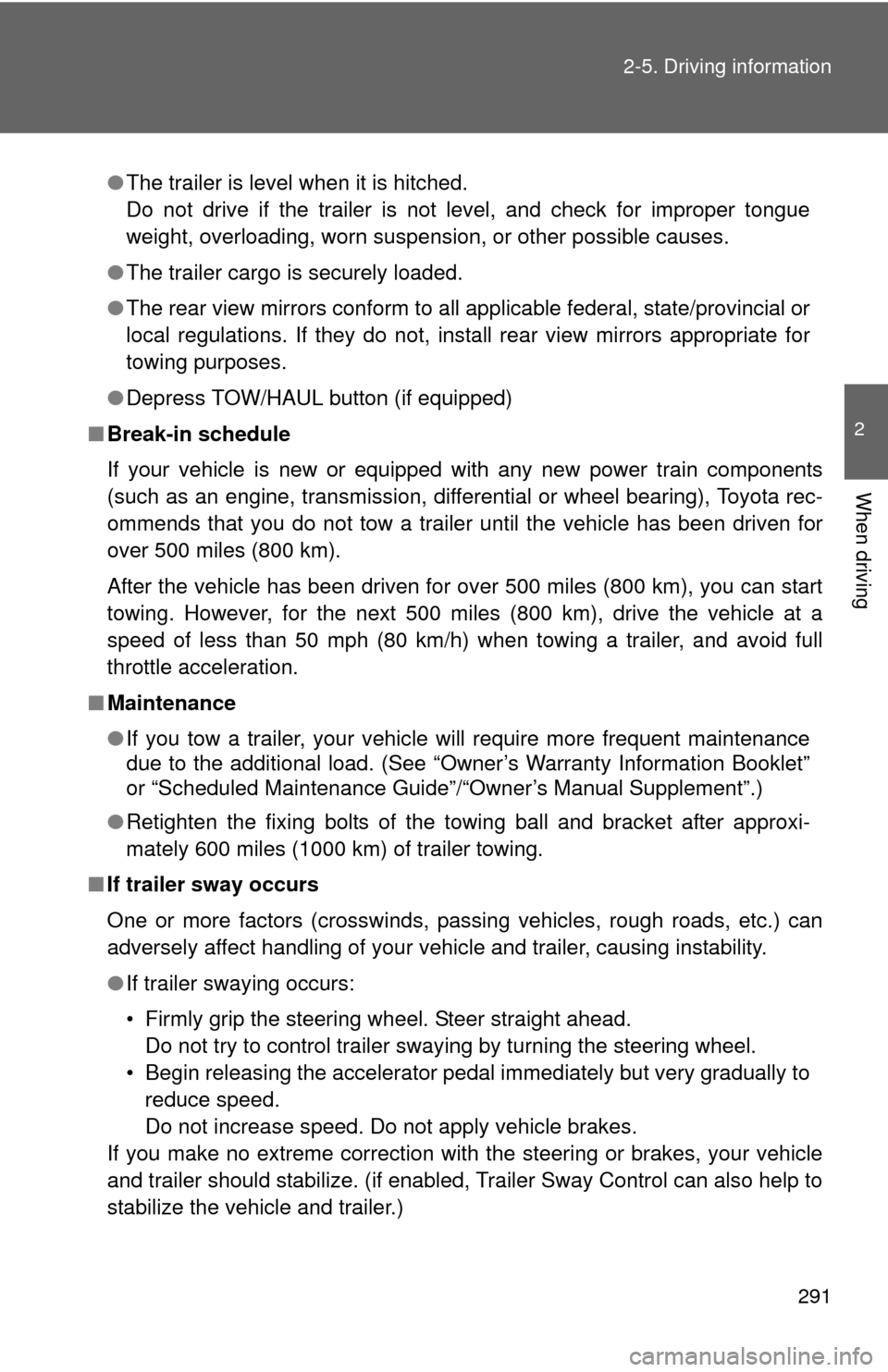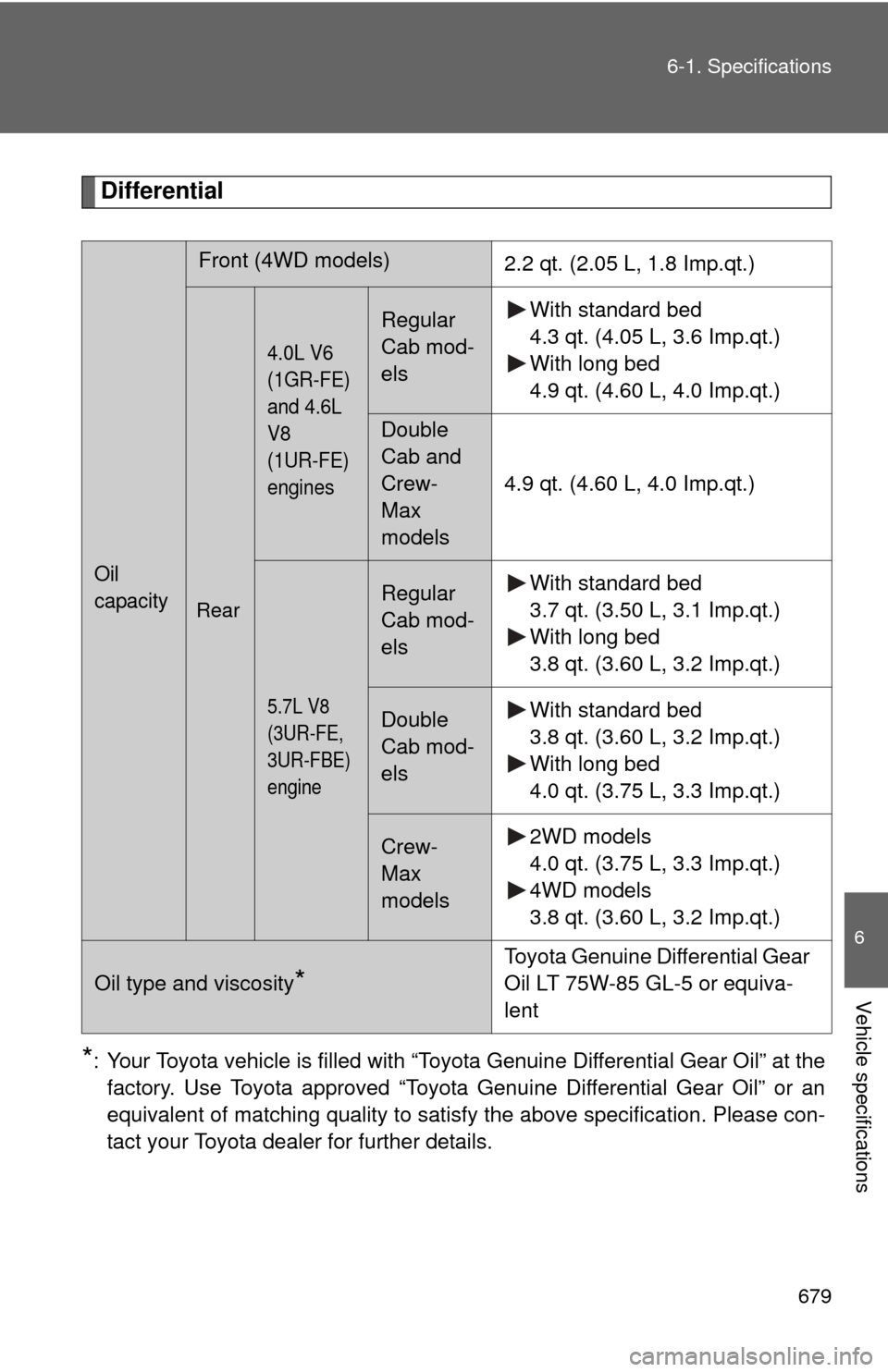Page 177 of 752
177
2-1. Driving procedures
2
When driving
NOTICE
■
When encountering flooded roads
Do not drive on a road that has flooded after heavy rain etc. Doing so may
cause the following serious damage to the vehicle.
●Engine stalling
● Short in electrical components
● Engine damage caused by water immersion
In the event that you drive on a flooded road and the vehicle is flooded, be
sure to have your Toyota dealer check the following.
● Brake function
● Changes in quantity and quality of oil and fluid used for the engine, trans-
mission, transfer (4WD models), differentials, etc.
● Lubricant condition for the propeller shaft, bearings and suspension joints
(where possible) and the function of all joints, bearings, etc.
Page 261 of 752

261
2-5. Driving information
2
When driving
NOTICE
■
To prevent the water damage
●Take all necessary safety measures to ensure that water damage to the
engine or other components does not occur.
● Water entering the engine air intake will cause severe engine damage.
● Water entering the automatic transmission will cause deterioration in shift
quality, locking up of your transmission accompanied by vibration, and ulti-
mately damage.
● Water can wash the grease from wheel bearings, causing rusting and pre-
mature failure, and may also enter the differentials, transmission and
transfer case, reducing the gear oil’s lubricating qualities.
■ When you drive through water
If driving through water, such as when crossing shallow streams, first check
the depth of the water and the bottom of the river bed for firmness. Drive
slowly and avoid deep water.
■ Inspection after off-road driving
●Sand and mud that has accumulat ed in brake drums and around brake
discs may affect braking efficiency and may damage brake system compo-
nents.
● Always perform a maintenance inspection after each day of off-road driv-
ing that has taken you through rough terrain, sand, mud, or water. For
scheduled maintenance information, refer to the “Scheduled Maintenance
Guide” or “Owner’s Manual Supplement”.
Page 291 of 752

291
2-5. Driving information
2
When driving
●
The trailer is level when it is hitched.
Do not drive if the trailer is not level, and check for improper tongue
weight, overloading, worn suspension, or other possible causes.
● The trailer cargo is securely loaded.
● The rear view mirrors conform to all applicable federal, state/provincial or
local regulations. If they do not, instal l rear view mirrors appropriate for
towing purposes.
● Depress TOW/HAUL button (if equipped)
■ Break-in schedule
If your vehicle is new or equipped with any new power train components
(such as an engine, transmission, differential or wheel bearing), Toyota rec-
ommends that you do not tow a trailer until the vehicle has been driven \
for
over 500 miles (800 km).
After the vehicle has been driven for over 500 miles (800 km), you can s\
tart
towing. However, for the next 500 miles (800 km), drive the vehicle at a
speed of less than 50 mph (80 km/h) when towing a trailer, and avoid full
throttle acceleration.
■ Maintenance
●If you tow a trailer, your vehicle will require more frequent maintenance
due to the additional load. (See “Owner’s Warranty Information Booklet”
or “Scheduled Maintenance Guide” /“Owner’s Manual Supplement”.)
● Retighten the fixing bolts of the towing ball and bracket after approxi-
mately 600 miles (1000 km) of trailer towing.
■ If trailer sway occurs
One or more factors (crosswinds, passing vehicles, rough roads, etc.) can
adversely affect handling of your vehicle and trailer, causing instability.
●If trailer swaying occurs:
• Firmly grip the steering wheel. Steer straight ahead.
Do not try to control trailer swaying by turning the steering wheel.
• Begin releasing the accelerator pedal immediately but very gradually to reduce speed.
Do not increase speed. Do not apply vehicle brakes.
If you make no extreme correction with the steering or brakes, your vehicle
and trailer should stabilize. (if enabled, Trailer Sway Control can also help to
stabilize the vehicle and trailer.)
Page 679 of 752

679
6-1. Specifications
6
Vehicle specifications
Differential
*: Your Toyota vehicle is filled with “Toyota Genuine Differential Gear Oil” at the
factory. Use Toyota approved “Toyota Genuine Differential Gear Oil” or an
equivalent of matching quality to satisfy the above specification. Please con-
tact your Toyota dealer for further details.
Oil
capacity
Front (4WD models) 2.2 qt. (2.05 L, 1.8 Imp.qt.)
Rear
4.0L V6
(1GR-FE)
and 4.6L
V8
(1UR-FE)
engines
Regular
Cab mod-
elsWith standard bed
4.3 qt. (4.05 L, 3.6 Imp.qt.)
With long bed
4.9 qt. (4.60 L, 4.0 Imp.qt.)
Double
Cab and
Crew-
Max
models
4.9 qt. (4.60 L, 4.0 Imp.qt.)
5.7L V8
(3UR-FE,
3UR-FBE)
engine
Regular
Cab mod-
els With standard bed
3.7 qt. (3.50 L, 3.1 Imp.qt.)
With long bed
3.8 qt. (3.60 L, 3.2 Imp.qt.)
Double
Cab mod-
elsWith standard bed
3.8 qt. (3.60 L, 3.2 Imp.qt.)
With long bed
4.0 qt. (3.75 L, 3.3 Imp.qt.)
Crew-
Max
models2WD models
4.0 qt. (3.75 L, 3.3 Imp.qt.)
4WD models
3.8 qt. (3.60 L, 3.2 Imp.qt.)
Oil type and viscosity*
Toyota Genuine Differential Gear
Oil LT 75W-85 GL-5 or equiva-
lent
Page 732 of 752
732
Abbreviation list
Abbreviation/Acronym list
ABBREVIATIONSMEANING
2WDTwo Wheel Drive
4WD Four Wheel Drive ABS Anti-Lock Brake System
ACC Accessory
AI-SHIFT Artificial Intelligence shifting ALR Automatic Locking Retractor
A-TRAC Active Traction Control
AUTO LSD Automatic Limited Slip Differential CAL Calibration
CRS Child Restraint System
ECU Electronic Control Unit
EDR Event Data Recorder ELR Emergency Locking Retractor
FFV Flexible Fuel Vehicle
GAWR Gross Axle Weight Rating
GCWR Gross Combination Weight Rating
GVWR Gross Vehicle Weight Rating I/M Emission inspection and maintenance
INFO Information
LATCH Lower Anchors and Tethers for Children LED Light Emitting DiodeLT Light truck
M + S Mud + Snow MMT Methylcy clopentadienyl Manganese Tricarbonyl
MTBE Methyl Tertiary Butyl Ether
OBD On Board Diagnostics
PWR Power